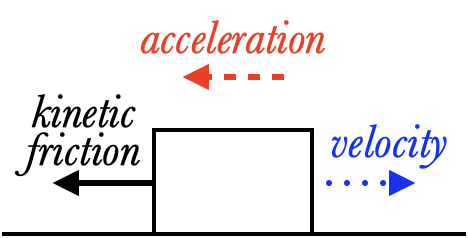Acceleration
Acceleration, like velocity, is a vector quantity.Column

If the acceleration points in the same-ish direction as the velocity, then the object will speed up
Column

If the acceleration points in the opposite-ish direction as the velocity, then the object will slow down.
Column

If the acceleration is perpendicular to the velocity, then the speed doesn't change at all (although the velocity will change direction).
The acceleration points in the direction the object is going to turn. If the object is going around a curve, the acceleration points toward the center of the curve.


Remember how Kinetic Friction always points in the direction opposite motion? That means that if kinetic friction is the only force acting, the net force and thus the acceleration point opposite the motion. This is why kinetic friction makes things slow down.